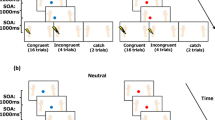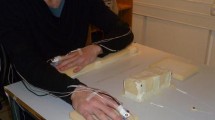Abstract
This study examines how the regularity of visual stimuli approaching the body influences spatial expectations of subsequent somatosensory stimuli by recording event-related brain potentials (ERPs) during a simple reaction time (RT) task involving responses to somatosensory stimuli. Twenty-one participants were instructed to put their arms on a desk, and three LEDs were placed equidistantly between their arms. Electrical stimuli were presented with a high probability (80%) of being applied to one wrist and a low probability (20%) of being applied to the opposite wrist. One trial was composed of three visual stimuli followed by one electrical stimulus. In the regular approach condition, LEDs flashed sequentially toward the wrist with the high-probability somatosensory stimulus. In the irregular approach condition, the first and second visual stimuli were presented randomly, but the third visual stimulus was invariably presented near the wrist with the high-probability stimulus. In both conditions, RTs for low-probability stimuli were slower than those for high-probability stimuli, and the low-probability stimuli elicited larger P3 amplitudes than the high-probability stimuli. Furthermore, the largest P3 amplitude was elicited by low-probability stimuli under the regular approach condition, whereas the amplitudes of contingent negative variation (CNV) elicited before the presentation of the somatosensory stimuli did not differ between conditions. These results indicate that regularity of visual stimuli approaching the body facilitates an automatic spatial expectation for subsequent somatosensory stimuli.



Similar content being viewed by others
References
Cohen J (1988) Statistical power analysis for the behavioral Sciences. 2nd edn., Lawrence Earlbaum Associates, Hillsdale
Craig CJ (2005) The trajectory effect in intermodal temporal order judgments. Perception 34:357–370. doi:10.1068/p5293
Delorme A, Makeig S (2004) EEGLAB: An open source toolbox for analysis of single trial EEG dynamics. J Neurosci Methods 134:9–21. doi:10.1016/j.jneumeth.2003.10.009
Donchin E (1981) Surprise! ... Surprise? Psychophysiol 18: 493–513. doi:10.1111/j.1469-8986.1981.tb01815.x
Duncan-Johnson C C, Donchin E (1977) On quantifying surprise: the variation of event-related potentials with subjective probability. Psychophysiol 14: 456–467. doi:10.1111/j.1469-8986.1977.tb01312.x
Forster B, Sambo C F, Pavone E F (2009) ERP correlates of tactile spatial attention differ under intra- and intermodal conditions. Biolog Psychol 82: 227–233. doi:10.1016/j.biopsycho.2009.08.001
Gillmeister H, Forster B (2010) Vision enhances selective attention to body-related information. Neurosci Lett 483:184–188. doi:10.1016/j.neulet.2010.08.004
Greenhouse SW, Geisser S (1959) On methods in the analysis of profile data. Psychometrika 24:95–112. doi:10.1007/BF02289823
Katayama J, Polich J (1998) Stimulus context determines P3a and P3b. Psychophysiol 35: 23–33. doi:10.1111/1469-8986.3510023
Kimura T, Katayama J (2015) Approach of visual stimuli modulates spatial expectations for subsequent somatosensory stimuli. Int J Psychophysiol 96:176–182. doi:10.1016/j.ijpsycho.2015.04.002
Lopez-Calderon J, Luck S J (2014) ERPLAB: An open-source toolbox for the analysis of event-related potentials. Front Hum Neurosci 8:213. doi:10.3389/fnhum.2014.00213
Meehan SK, Legon W, Staines WR (2009) Spatiotemporal properties modulate intermodal influences on early somatosenory processing during sensory-guided movement. Clin Neurophysiol 120:1371–1380. doi:10.1016/j.clinph.2009.05.005
Mognon A, Jovicich J, Bruzzone L, Buiatti M (2011) ADJUST: An automatic EEG artifact detector based on the joint use of spatial and temporal features. Psychophysiol 48: 229–240. doi:10.1111/j.1469-8986.2010.01061.x
Sambo CF, Forster B (2011) Sustained spatial attention in touch: modality-specific and multimodal mechanisms. Sci World J 11:199–213. doi:10.1100/tsw.2011.34
Shaffer JP (1986) Modified sequentially rejective multiple test procedures. J Am Stat Assoc 81:826–831. doi:10.2307/2289016
Spence C (2010) Crossmodal spatial attention. Ann N Y Acad Sci 1191:182–200. doi:10.1111/j.1749-6632.2010.05440.x
Spence C (2013) Just how important is spatial coincidence to multisensory integration? Evaluating the spatial rule. Ann N Y Acad Sci 1296:31–49. doi:10.1111/nyas.12121
Spence C, Pavani F, Driver J (2000) Crossmodal links between vision and touch in covert endogenous spatial attention. J Exp Psychol Hum Percept Perform 26: 1298–1319. doi:10.1037//0096-1523.26.4.1298
Spence C, Baddeley R, Zampini M, James R, Shore I D (2003) Multisensory temporal order judgments: When two locations are better than one. Percept Psychophys 65: 318–328. doi:10.3758/BF03194803
Walter WG, Cooper R, Aldridge VJ, McCallum WC, Winter AL (1964) Contingent negative variation: an electric sign of sensorimotor association and expectancy in the human brain. Nature 203:380–384. doi:10.1038/203380a0
Wesslein A K, Spence C, Frings C (2014) Vision affects tactile target and distractor processing even when space is task-irrelevant. Front Psychol 5: 84. doi:10.3389/fpsyg.2014.00084
Acknowledgements
Part of this study was supported by a Grant-in-Aid for Scientific Research (B) (25285206) from the Japan Society for the Promotion of Science (JSPS) awarded to JK. The conducting of the experiment was supported by Special Research Fund A of 2015 funds from Kwansei Gakuin University awarded to JK. The experiment was conducted as a part of the project supported by the Ministry of Education, Culture, Sports, Science and Technology (MEXT), Japan, for the Strategic Research Foundation at Private Universities (2015–2019; Project number S1511032) to the Center for Applied Psychological Science (CAPS), Kwansei Gakuin University.
Author information
Authors and Affiliations
Corresponding author
Rights and permissions
About this article
Cite this article
Kimura, T., Katayama, J. Regularity of approaching visual stimuli influences spatial expectations for subsequent somatosensory stimuli. Exp Brain Res 235, 1657–1663 (2017). https://doi.org/10.1007/s00221-016-4863-6
Received:
Accepted:
Published:
Issue Date:
DOI: https://doi.org/10.1007/s00221-016-4863-6




